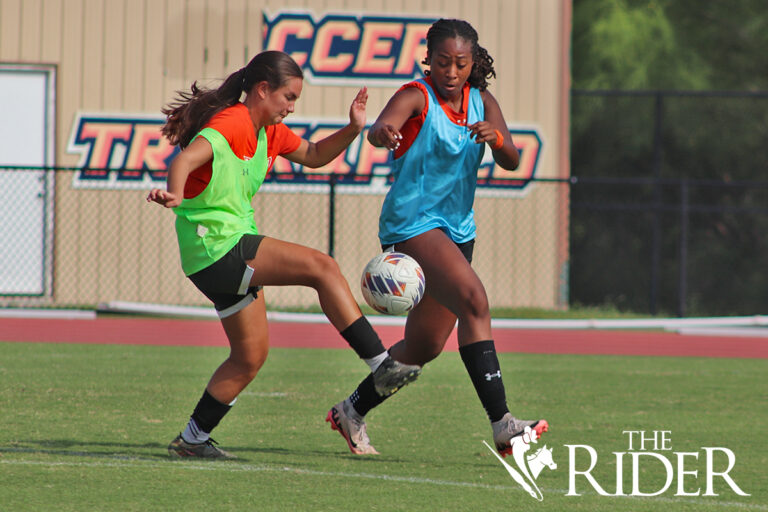UTRGV professor releases new children’s series
Sol Garcia | THE RIDER

What was supposed to be a regular afternoon at the public pool turns into an exhilarating adventure when three Mexican American cousins land in an alternate universe. In this universe, the city is the same as they left behind, except it’s twisted with its seemingly endless road … and its monsters. If they want to return home, the three cousins will need to find a way to defeat those monsters.
That’s the plot of “13th Street,” a six-book children’s mystery series, by David Bowles, UTRGV associate professor of English in the department of Literatures and Cultural Studies.
Through HarperCollins, the first three books in the series were published in July. The fourth book will come out in November, while book five will be released next spring. The final book should be published next fall.
In “13th Street,” Bowles ensures all characters are Latinos and includes Spanish dialogue. The three cousins are related by their Mexican American mothers. Malia, the tough, initiative-taking cousin is also Dominican American from her father’s side. The father of intelligent Ivan is Jewish American. Dante, the cute, guero of the family and the third cousin, is Mexican American by his father. With this representation, Mexican American children can see themselves in these books, and non-Mexican American children can learn there’s a lot of diversity in this community, Bowles said.
“I wanted to bring … the real diversity that exists in the Latinx community, but also, like, in the Mexican American community,” he said. “We all share similar culture, cuisine and stories, and so forth, but, like, everybody’s family is different.”
Readers can learn lessons about the value of friendship and family in “13th Street.” In the Mexican American community, many children’s first friends are their primos (cousins), Bowles said, as was the case with him.
“They are … your first taste of what it means to have a friendship with somebody,” he said. “That was a major important part of it, and, like, learning to appreciate the strengths in people that are different from you, because each of these characters are different from the other.”
Each character has their own arc to go on, and that includes mistakes on the way, Bowles said.
“I thought it was important to see that you can make mistakes and you can fix them,” he said. “Those are some of the kinds of lessons I try to teach, but while also having lots and lots of fun, having monsters, and being gross and making … jokes all the time.”
Bowles has published about 25 other books. Some books are young adult, children’s like “13th Street,” adult and translations. While his books are different genres, there is one similarity between them all: a connection to the Mexican American community, Mexico’s roots, or Aztec and Mayan mythology.
“There is a thread throughout, you know, specifically with Mexican Americans, the Mexican border community being the center, and then, like, delving into our roots, going back in time,” he said.
One of the reasons he chose this theme is the huge lack of representation of Mexican Americans in literature. Bowles can recall his first time reading a work by a Mexican American in an English class. It was at Pan American University, now UTRGV, and it was written by Sandra Cisneros.
Bowles remembers thinking, “I was like, ‘Oh, wait a minute, [a] Mexican American can write books. Of course you can. Why have I not been reading any of them?’”
He couldn’t read them because there weren’t any, Bowles said.
“Publishers weren’t publishing them,” he said. “That has improved somewhat, but it was definitely one of the things that made me, as I realized I wanted to be a writer, decide to focus on our community, because our community deserves to be represented in literature … and deserves to be at the center of school curricula.”
Kate Horan, director of the McAllen Public Library, agrees there’s underrepresentation of Mexican Americans and other people of color, especially in publishing. Like Bowles, she believes these children need to see themselves in literature, and children who aren’t of color need to see them, too, she said.
“When we normalize like that, with children of color as the protagonists of the books, I think, then we’re making some progress,” Horan said.
Students can also now get a different experience while enrolled in an English class with Bowles, said Douglas LaPrade, department chair of Literatures and Cultural Studies.
“That’s really exciting that [students] can actually study with an author who produces the kind of books that are studied in English classes across the country,” he said.
About 26 years ago, LaPrade had Bowles as a graduate student and can recall him describing his stories. LaPrade described him as “interested” and a hard worker.
“He made an impression, so … I’m not surprised by his success,” he said.
Bowles has been writing before university and before his first publication through a small press. His grandmother, the family storyteller, led him to start writing in his childhood.
“She taught me to love stories, and I became interested in writing after that,” he said.
Students interested in becoming published authors should write what they feel strongly about and who they are, Bowles advises.
“Find a way to blend your identity with things that you’re passionate about,” he said.






